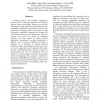Free Online Productivity Tools
i2Speak
i2Symbol
i2OCR
iTex2Img
iWeb2Print
iWeb2Shot
i2Type
iPdf2Split
iPdf2Merge
i2Bopomofo
i2Arabic
i2Style
i2Image
i2PDF
iLatex2Rtf
Sci2ools
WCRE
2002
IEEE
2002
IEEE
Estimating Potential Parallelism for Platform Retargeting
Scientific, symbolic, and multimedia applications present diverse computing workloads with different types of inherent parallelism. Tomorrow’s processors will employ varying combinations of parallel execution mechanisms to efficiently harness this parallelism. The explosion of consumer products that incorporate high performance embedded computing will increase the stratification of the processor design space. However, existing code assets are limited to sequential expression of what should be highly parallel algorithms. Retargeting to parallel mechanisms is difficult, but can provide significant increases in efficiency. It is desirable to estimate potential parallelism before undertaking the expensive process of reverse engineering and retargeting. This paper presents a lightweight dynamic analysis technique for characterizing the types of parallelism that are inherent in a given program to estimate the potential benefit of retargeting. The technique is validated on Spec95 and Media...
Inherent Parallelism | Parallel Execution Mechanisms | Potential Parallelism | Software Engineering | WCRE 2002 |
| Added | 16 Jul 2010 |
| Updated | 16 Jul 2010 |
| Type | Conference |
| Year | 2002 |
| Where | WCRE |
| Authors | Linda M. Wills, Tarek M. Taha, Lewis B. Baumstark Jr., D. Scott Wills |
Comments (0)

